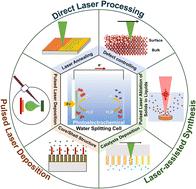当前位置:
X-MOL 学术
›
Mater. Chem. Front.
›
论文详情
Our official English website, www.x-mol.net, welcomes your feedback! (Note: you will need to create a separate account there.)
Recent advances in vacuum- and laser-based fabrication processes for solar water-splitting cells
Materials Chemistry Frontiers ( IF 7 ) Pub Date : 2024-04-12 , DOI: 10.1039/d3qm01336g Jinhyeong Kwon, Seonmi Ko, Hyeonwoo Kim, Hyo Jin Park, Changwook Lee, Junyeob Yeo
Materials Chemistry Frontiers ( IF 7 ) Pub Date : 2024-04-12 , DOI: 10.1039/d3qm01336g Jinhyeong Kwon, Seonmi Ko, Hyeonwoo Kim, Hyo Jin Park, Changwook Lee, Junyeob Yeo

|
The demand for zero-emission energy sources has recently intensified, driven by growing concerns over global warming and climate change. Among various renewable energy technologies, solar water-splitting cells have emerged as a promising avenue for harnessing hydrogen energy by exciting photo-carriers. These cells are typically fabricated using vacuum-based techniques such as physical vapour deposition, atomic layer deposition, chemical vapour deposition, and sputtering. Although these methods deliver moderate performance, they are characterised by extensive production steps and significant costs. This review examines the current vacuum-based fabrication processes for solar water-splitting cells and explores advanced or alternative techniques, with a particular emphasis on optical methods, especially laser processing, for fabricating these cells.
中文翻译:

太阳能水分解电池真空和激光制造工艺的最新进展
由于对全球变暖和气候变化的日益担忧,对零排放能源的需求最近有所增加。在各种可再生能源技术中,太阳能水分解电池已成为通过激发光载流子利用氢能的有前途的途径。这些电池通常使用基于真空的技术制造,例如物理气相沉积、原子层沉积、化学气相沉积和溅射。尽管这些方法的性能中等,但其特点是生产步骤繁琐且成本高昂。本综述研究了当前基于真空的太阳能水分解电池制造工艺,并探索了先进或替代技术,特别强调了用于制造这些电池的光学方法,尤其是激光加工。
更新日期:2024-04-12
中文翻译:

太阳能水分解电池真空和激光制造工艺的最新进展
由于对全球变暖和气候变化的日益担忧,对零排放能源的需求最近有所增加。在各种可再生能源技术中,太阳能水分解电池已成为通过激发光载流子利用氢能的有前途的途径。这些电池通常使用基于真空的技术制造,例如物理气相沉积、原子层沉积、化学气相沉积和溅射。尽管这些方法的性能中等,但其特点是生产步骤繁琐且成本高昂。本综述研究了当前基于真空的太阳能水分解电池制造工艺,并探索了先进或替代技术,特别强调了用于制造这些电池的光学方法,尤其是激光加工。



























 京公网安备 11010802027423号
京公网安备 11010802027423号